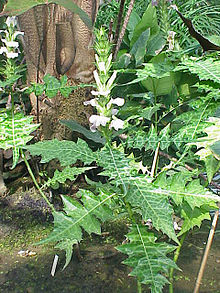
Back أقنثا Arabic اقنثا ARZ Акант (гъветӀ-хер) AV Акант (расліна) Byelorussian Меча стъпка Bulgarian Acanthus (gènere) Catalan Acanthus CEB Akantus Danish Akanthus (Gattung) German Άκανθος (φυτό) Greek
| Acanthus | |
|---|---|

| |
| Acanthus montanus | |
| Scientific classification | |
| Kingdom: | Plantae |
| Clade: | Tracheophytes |
| Clade: | Angiosperms |
| Clade: | Eudicots |
| Clade: | Asterids |
| Order: | Lamiales |
| Family: | Acanthaceae |
| Subfamily: | Acanthoideae |
| Tribe: | Acantheae |
| Genus: | Acanthus L. (1753) |
| Species | |
|
See text | |
| Synonyms[1][2] | |
| |
Acanthus is a genus of about 30 species of flowering plants in the family Acanthaceae, native to tropical and warm temperate regions, with the highest species diversity in the Mediterranean Basin and Asia. This flowering plant is nectar-producing and depends on butterflies, such as Anartia fatima, and other nectar-feeding organisms to distribute its pollen. Common names include Acanthus and bear's breeches. The generic name derives from the Greek term ἄκανθος (akanthos) for Acanthus mollis, a plant that was commonly imitated in Corinthian capitals.[3][4]
The genus comprises herbaceous perennial plants, rarely subshrubs, with spiny leaves and flower spikes bearing white or purplish flowers. Size varies from 0.4 to 2 m (1.3 to 6.6 ft) in height.
- ^ Acanthus L. Plants of the World Online. Retrieved 26 January 2024.
- ^ "Acanthus". Germplasm Resources Information Network. Agricultural Research Service, United States Department of Agriculture.
- ^ ἄκανθος. Liddell, Henry George; Scott, Robert; A Greek–English Lexicon at the Perseus Project. Harper, Douglas. "acanthus". Online Etymology Dictionary.
- ^ Quattrocchi, Umberto (2000). CRC World Dictionary of Plant Names: A–C. CRC Press. p. 23. ISBN 978-0-8493-2675-2.